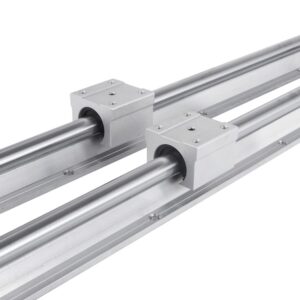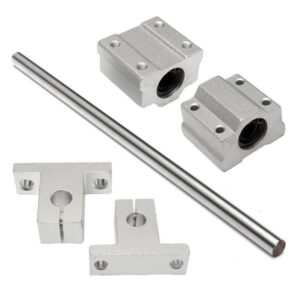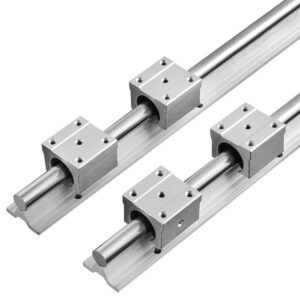Outline for “Types of Linear Rails”
| Main Topic | Subtopics |
|---|---|
| Introduction to Linear Rails | Definition, Purpose, Importance in industry |
| What are Linear Rails? | Structure, Function, Key components |
| Importance of Linear Rails in Engineering | Precision, Durability, Efficiency |
| Benefits of Using Linear Rails | Reduced friction, High load capacity, Long lifespan |
| Types of Linear Rails | Overview of classification |
| Profiled Linear Rails | Structure, Benefits, Applications |
| Round Shaft Linear Rails | Design, Advantages, Limitations |
| V-Groove Linear Rails | Functionality, Use cases, Strengths |
| Flat Linear Rails | Heavy-duty use, Industrial applications |
| Curved Linear Rails | Specialized motion, Robotics and automation |
| Miniature Linear Rails | Small-scale robotics, Medical equipment |
| Roller Linear Rails | High load handling, CNC applications |
| Self-Lubricating Linear Rails | Low maintenance, Clean environments |
| Plastic and Composite Linear Rails | Lightweight, Corrosion resistance |
| Magnetic Linear Rails | Frictionless motion, High-speed transport |
| Comparing Types of Linear Rails | Performance, Cost, Applications |
| Materials Used in Linear Rails | Steel, Aluminum, Stainless steel, Composites |
| Applications of Different Types | CNC machines, Robotics, Medical devices, Packaging |
| Choosing the Right Type of Linear Rail | Factors to consider: load, speed, environment |
| Installation and Setup | Mounting, Alignment, Best practices |
| Maintenance and Care | Cleaning, Lubrication, Troubleshooting |
| Innovations in Linear Rails | Smart rails, IoT integration, Lightweight designs |
| Future Trends in Linear Rails | Miniaturization, Sustainability, Green technology |
| Types of Linear Rails | Importance, Versatility, Reliability |
| FAQs | Six detailed FAQs with answers |
| Conclusion | Summary and final insights |
| Suggested Internal & External Links | For SEO and authority |
Introduction to Linear Rails
Linear rails may not be the most glamorous part of engineering, but they’re undoubtedly among the most important. They allow precise, controlled motion in straight lines — something essential for robotics, CNC machines, 3D printers, and medical devices. Without them, modern automation would grind to a halt.
The fascinating part? There are many types of linear rails, each designed for specific needs. From heavy-duty industrial systems to tiny medical robots, every application relies on a tailored rail design to achieve flawless motion.
What are Linear Rails?
A linear rail is a mechanical guide system that allows motion in one direction with minimal resistance. It typically includes:
A rail made of hardened steel or aluminum
A block or carriage that slides along the rail
Bearings or rollers that reduce friction
This simple design ensures smooth movement, even under heavy loads.
Importance of Linear Rails in Engineering
Linear rails play a vital role in engineering systems by providing:
Precision: Ensuring repeatable and accurate movements
Durability: Long lifespans even in harsh environments
Efficiency: Reduced energy loss through friction minimization
Every precision industry — from aerospace to healthcare — depends on linear rails to function reliably.
Benefits of Using Linear Rails
Why do engineers prefer linear rails over alternatives? Because they deliver:
Reduced Friction: Ensures smooth motion
High Load Capacity: Can support significant weights without bending
Long Lifespan: Designed for millions of cycles
Versatility: Suitable for both light and heavy applications
Quiet Operation: Essential for medical and cleanroom environments
These benefits explain why they’re standard in modern automation systems.
Types of Linear Rails
There isn’t just one type of linear rail — there are many, each with distinct advantages. Let’s explore the most important ones.
Profiled Linear Rails
Profiled or square rails are the most widely used. Their shape prevents twisting and misalignment, making them highly precise.
Benefits: High rigidity, excellent load distribution, long lifespan
Applications: CNC machines, 3D printers, automation lines
They are the go-to option for industries requiring precision machining.
Round Shaft Linear Rails
These rails feature a round shaft along which the carriage moves.
Advantages: Easy installation, cost-effective, adaptable
Limitations: Less rigid than profiled rails
Applications: Light-duty equipment, simple automation systems
They’re popular for projects where cost and simplicity matter more than high precision.
V-Groove Linear Rails
V-groove designs use rollers running along V-shaped tracks.
Strengths: Smooth motion, durable under moderate loads
Applications: Industrial doors, factory automation, conveyors
Their ruggedness makes them suitable for outdoor or heavy-use environments.
Flat Linear Rails
Flat rails are designed to carry heavy loads across large equipment.
Benefits: High strength, stability under pressure
Applications: Heavy-duty manufacturing, mining equipment
They shine in industries where robustness trumps speed.
Curved Linear Rails
Not all motion is straight. Curved rails support movement along arcs.
Applications: Robotics, packaging machinery, stage equipment
Benefits: Flexible design for specialized motion
They expand the possibilities for creative and complex mechanical systems.
Miniature Linear Rails
Miniature rails provide high precision in small sizes.
Applications: Medical robotics, electronics manufacturing, micro-machines
Benefits: Compact, accurate, ideal for space-limited setups
Perfect for industries where precision must fit into tight spaces.
Roller Linear Rails
Instead of ball bearings, these use rollers for higher load capacity.
Benefits: Handle heavy loads, reduced wear, smoother travel
Applications: CNC milling, automotive manufacturing, aerospace
They’re built for strength and durability in high-demand environments.
Self-Lubricating Linear Rails
These rails incorporate lubrication systems that reduce the need for manual oiling.
Advantages: Low maintenance, clean operation
Applications: Food processing, cleanrooms, medical equipment
Ideal where contamination must be avoided.
Plastic and Composite Linear Rails
Lightweight alternatives to metal-based rails.
Benefits: Corrosion resistance, lightweight, affordable
Applications: Furniture, low-load automation, clean industries
Their non-metallic properties make them suitable for unique applications.
Magnetic Linear Rails
These futuristic rails use magnetic fields for near-frictionless motion.
Benefits: Ultra-smooth travel, minimal wear, high speed
Applications: High-tech transport, precision labs, advanced robotics
Though expensive, they represent the cutting edge of motion technology.
Comparing Types of Linear Rails
| Type | Strengths | Applications |
|---|---|---|
| Profiled | Precision, rigidity | CNC, automation |
| Round Shaft | Easy setup, cost-effective | Light automation |
| V-Groove | Rugged, smooth | Conveyors, doors |
| Flat | Heavy-duty | Mining, industrial |
| Curved | Arc motion | Robotics, packaging |
| Miniature | Compact, precise | Medical, electronics |
| Roller | High load capacity | CNC, aerospace |
| Self-Lubricating | Low maintenance | Food, cleanrooms |
| Plastic/Composite | Lightweight, corrosion-resistant | Furniture, clean setups |
| Magnetic | Frictionless, advanced | Labs, transport |
Materials Used in Linear Rails
The choice of material is key:
Steel: Strong, durable, high load capacity
Aluminum: Lightweight, corrosion-resistant
Stainless Steel: Hygienic, resistant to moisture
Composites: Affordable, lightweight, flexible
Each material balances strength, cost, and environment-specific benefits.
Applications of Different Types
CNC Machines: Precision and rigidity from profiled or roller rails
Robotics: Flexibility with curved and miniature rails
Medical Devices: Hygiene-friendly stainless steel and miniature rails
Packaging Systems: V-groove and curved rails for fast movement
Linear rails power nearly every sector that demands accuracy.
Choosing the Right Type of Linear Rail
Factors to consider include:
Load Requirements: Heavier loads require roller or flat rails
Speed Needs: Magnetic or profiled rails excel at high speeds
Environment: Stainless steel for medical, composites for lightweight applications
Budget: Round shaft and composite rails offer affordable options
Selecting the right type ensures efficiency and cost savings.
Installation and Setup
Best practices for installation include:
Proper Alignment: Prevents binding and uneven wear
Use of Correct Fasteners: Ensures stability
Lubrication: Extends lifespan and reduces friction
Professional setup ensures long-term reliability.
Maintenance and Care
Even low-maintenance rails need attention:
Cleaning: Remove dust and debris regularly
Lubrication: Use recommended greases or oils
Inspection: Watch for unusual noise or movement
Routine checks help prevent unexpected breakdowns.
Innovations in Linear Rails
Recent innovations include:
Smart Rails: IoT-enabled sensors track performance
Self-Lubricating Rails: Reduced manual maintenance
Lightweight Composites: Lower energy use in automation
These advances push the boundaries of what linear rails can do.
Future Trends in Linear Rails
The future is exciting:
Miniaturization: More precise micro-rails for nanotech
Sustainability: Eco-friendly materials and designs
Advanced Magnetic Systems: Faster, smoother travel
These trends will shape industries for decades to come.
Types of Linear Rails
The different types of linear rails each serve unique needs. From the high precision of profiled rails to the rugged strength of flat rails and the futuristic performance of magnetic designs, these components remain the foundation of modern motion systems.
FAQs
What are the main types of linear rails?
Profiled, round shaft, V-groove, flat, curved, miniature, roller, self-lubricating, plastic/composite, and magnetic rails.
Which type is best for CNC machines?
Profiled and roller linear rails are ideal for CNC applications due to their rigidity and load capacity.
Do linear rails require lubrication?
Yes, though some advanced designs are self-lubricating.
Are plastic linear rails reliable?
Yes, for lightweight and corrosion-resistant applications, though not for heavy loads.
What are magnetic linear rails used for?
They are used in high-speed, frictionless systems such as labs and transport technology.
Can curved linear rails be customized?
Yes, they are often designed to match specific robotic or automation needs.
Conclusion
The many types of linear rails showcase just how diverse engineering solutions can be. Whether in heavy industry, delicate medical tools, or innovative robotics, linear rails ensure smooth, accurate, and efficient motion. By understanding the differences and benefits of each type, engineers and makers alike can choose the perfect rail for their project.
As industries evolve, linear rails will only become smarter, greener, and more specialized — securing their role as the silent drivers of modern technology.
Suggested Links
Internal Links (your site):
Guide to CNC Machine Components
Linear Motion vs Rotary Motion Systems
Maintenance Tips for Bearings and Rails
External Links (authoritative sources):




